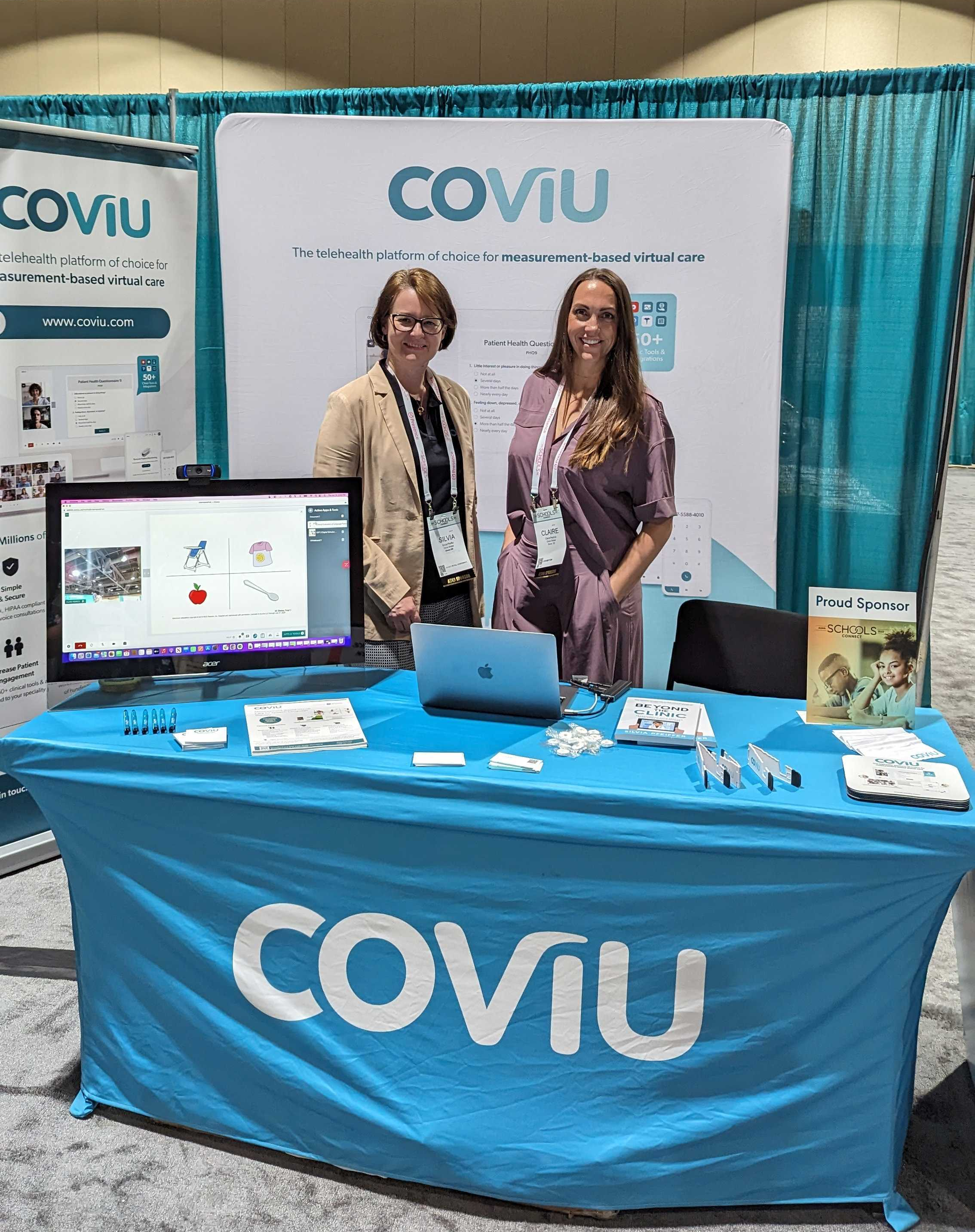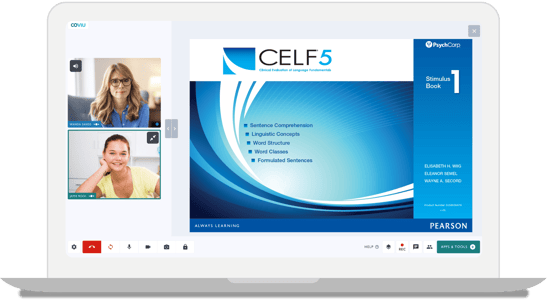Enabling Telepractice for School Districts at ASHA
Coviu exhibited at the ASHA Schools Connect Conference 2023 in beautiful Long Beach, California. From July 13th to 15th, educators and professionals in the speech-language pathology field gathered to exchange knowledge and explore the latest advancements in their field.
One of the most pressing challenges faced by school districts is the shortage of speech language pathologists (SLPs) on the ground. Coviu presented a solution through their telehealth platform that made school districts think outside the box and that offers a multitude of advantages.

Coviu was present at the ASHA Schools Connect conference with our CEO Dr. Silvia Pfeiffer and our Executive VP of Sales US Claire Pedrick. This senior team also presented in a pre-conference Workshop that focused on managing workload in school districts.
Challenges of School Districts
The first key insight that we took away from the workshop is that student case numbers are increasing. There are several causes:
-
Post-pandemic, there are a lot more students in schools that require speech language pathology support because of the service reductions during the pandemic.
-
An increasingly social media raised school cohort further exhibits challenges in interpersonal communication and behaviors.
-
Criteria for students to be eligible for speech language pathology have become more sensitive and a lot more students are assessed to exhibit a disability.
-
There is over-servicing with some students staying in therapy for many years.
The second key insight is that this increasing demand for SLPs is meeting a shortage of available SLPs. There are again several causes for this situation:
-
The number of available SLPs is not growing as it's not a well-paid profession with very few remuneration increases in recent years.
-
The majority of SLPs are young women who often leave the workforce when they start families.
-
Schools are increasingly turning into dangerous workplaces with SLPs fearing for their safety and preferring to work in private practice.
Combining these two challenges creates an explosive situation that school districts have to face as they try to manage the gap between demand and supply. One of the consequences is that students often have to wait for an extended period of time before they can receive the necessary speech therapy. Additionally, some SLPs are burdened with a caseload of over 65 cases, which is significantly higher than the national average of 48 cases according to an ASHA survey conducted in 2022. Moreover, the recommended caseload is actually closer to 35 cases, highlighting the overwhelming workload faced by these professionals. This is leading to massive burnout in SLPs, leading to therapists leaving the workforce which further exacerbates the situation.
The biggest problem for school districts that are not able to fill their speech language pathology gaps is that they lose compliance with state and federal laws around meeting the communication needs of students, e.g. compliance with ESSA (Every Student Succeeds Act), Americans with Disabilities Act or Disabilities Education Act (IDEA). This exposes school districts to requirements for corrective action and financial and legal risks with disgruntled parents.

Solutions for School Districts
The solutions that the workshop advocated to the demand-supply challenge for speech therapy include the following approaches that are targeting a reduction of the demand:
-
Train SLPs to be stricter in screening students for therapy by following the IDEA exclusionary factors that require to only quality students that have a unique need as a result of their disability. Specifically, the goal is to remediate a student's communication disorder that is impacting academic achievement and functional disorder.
-
Train SLPs to be more strict when re-evaluating the students that they are treating and graduate them from therapy faster. A key insight here was that the SLPs need to assess students collaboratively with teachers and school psychologists to determine if their therapy goals had been met.
The workshop realized that these approaches will lead to some reduction in caseload, however, will for many school districts not be sufficient to address their challenges. It was pointed out that hiring is not the only way to cover demand, but that telepractice is another opportunity to cover staffing gaps.
At the conference, we spoke with many different school districts and found that some are already using telepractice to address their staffing gaps - there are several different approaches:
-
Partner with an external speech therapy provider network or staffing agency that can provide a teletherapist to fill gaps in staffing. This can be a permanent service or cover a short-term maternity or medical leave coverage.
-
Provide flexibility to employed speech therapists by offering them to deliver speech therapy via telepractice for some days of the week. This is particularly useful where speech therapists spend a lot of "windshield time" (i.e. driving) to get to the schools that they service, which is unproductive time.
-
Hire fully-remote speech therapists to cover certain schools, particularly remote schools, permanently.
Most states now allow the use of telepractice to deliver services into schools.
What speech therapists say about telepractice
We also spoke to a lot of speech therapists (SLPs) at the conference. There are many reasons why speech therapists like telepractice:
-
It gives them the flexibility to gain work-life balance, particularly with family requirements.
-
It gives them a chance to remain in the workforce despite part-time family requirements. This is an untapped source of staffing that is only unlocked through telepractice.
-
It reduces commute time, which is dangerous and wasteful.
-
It is safer for them to deliver the service from home than be in a potentially dangerous environment - some of the SLPs that we've spoken to have been involved in active shooter situations and suffer from anxiety every time they are at a school.
Why is there little use of telepractice at schools
Given all these advantages of telepractice, we still observed very little use of it in school districts. We heard about the challenges encountered in rolling it out. Two key challenges stand out:
-
Operational: the schools have to organize their on-the-ground staff to support taking the children out of their classes or breaks into the teletherapy sessions, which causes extra effort on the teaching staff and potentially extra cost on the ground.
-
Functional: the delivery of standardized assessments, which are key to the evaluation and re-evaluation of children, is deemed impossible to do via telepractice. In fact, many SLPs were severely stressed out during the pandemic when using standard video conferencing applications for delivering paper-based assessments leading to severely longer assessment times and uncertainty on the validity of the outcomes. This has made SLPs believe that assessments must be delivered in person.
There are ways to address both of these challenges:
-
Operational: this must be reformulated as an opportunity, not a challenge. The task of an SLP is to create impact with children so they can return to functioning students in the classroom. In our experience, it is advantageous to have a teacher's aid participate in a teletherapy session as they learn a lot about the special needs of the student and can support the student in the classroom in reinforcing their learnings from their teletherapy sessions. The use of teletherapy actually enforces more collaboration at the school, creating knowledge transfer and a better learning environment for the children.
-
Functional: the functional challenge of not being able to deliver assessments remotely has traditionally been hard to overcome as most available telehealth platforms don't allow for a validated delivery of assessments. Coviu has solved this problem and will thus allow school districts to address their delays in assessing children by using tele-assessments!

The Coviu Solution
Coviu provides a telehealth platform that covers both use cases:
-
Tele-assessments: in use as part of testing eligibility criteria and as part of re-evaluating progressing students.
-
Tele-therapy: in use to address the identified speech-language impairment.
Tele-Assessments
To enable tele-assessments, Coviu has partnered with Pearson Clinical to provide the most commonly used standardized speech and language assessments in a valid way during telepractice:
-
CELF-5: 'Clinical Evaluation of Language Fundamentals v5' assesses a student’s communication and language skills of students aged 5 and above.
-
EVT-3 A and EVT-3 B: 'Expressive Vocabulary Test v3' assesses expressive vocabulary and word retrieval capabilities of students aged 2:6 and above.
-
GFTA-3: 'Goldman-Fristoe Test of Articulation v3' provides accurate scores for making diagnostic and placement decisions of students aged 2 and above.
-
PPVT-5 A and PPVT-5 B: 'Peabody Picture Vocabulary Test v5' assesses receptive vocabulary acquisition of students 2:6 and above.
-
CELF P-3: 'Clinical Evaluation of Language Fundamentals® Preschool-3' which assesses aspects of language necessary for preschool children to meet the language demands of the classroom.*
Coviu will extend this list and partner with other assessment publishers to enable their assessments to be available on our platform also.
What is it that makes Coviu's implementation of the assessments so different?
First of all, Coviu has a scientific approach to enabling assessments. Coviu first implemented support for the CELF-5 in 2018 and allowed a University to undertake research about the validity of the outcomes of administering the CELF-5 in person in comparison to a tele-assessment setup. This created the specific setup that Coviu now uses for all implemented assessments. Several other assessments have been independently validated also. You can see the related research publications here.
The concrete setup that makes Coviu's setup unique is as follows:
-
The student's experience is that of a clean assessment environment where they only see the assessor and the stimulus materials and no other distracting buttons, or their own video.
-
If the student leaves the assessment to look at other web pages or applications, the assessor gets notified about the distraction.
-
The assessor gets to see the stimulus material and sees all mouse movements and mouse clicks (or touch screen touches) by the student. The clicks are numbered in the order in which the child clicks. This helps with multiple-choice setups.
-
The assessor also gets to see the full test instructions, any timers, and any sound files that need playing and also sees the expected answers in a sidebar that is not shared with the student.*
-
The assessor also gets to navigate to any subtest and any item in a subtest directly and can hide any stimulus material pages while looking for a specific page to start from or continue on.
Coviu thus provides a very user-friendly interface that replicates the test situation and, in fact, simplifies delivering the assessments. This has the capacity to revolutionize assessment delivery with students, enhancing accessibility and flexibility for speech therapists and schools.
Tele-Therapy
Coviu also supports the delivery of speech therapy sessions through rich interactive tools. You can use your own materials or other digital stimulus materials or even interact with materials published by other stimulus material providers.
Some key things that support your therapy sessions:
-
Interactive whiteboard with the child and therapist being able to draw at the same time; it also includes fun stickers that children love.
-
Ability to line up a number of stimulus materials before the session and switch between them with just one click during the session.
-
Ability to build your own custom forms and share them in the call for the children to fill in - this also allows building in freely available or customized assessments.
-
Ability to put two stimulus materials next to each other during a session.
-
Ability to share an image or pdf file and do a screen share and be able to draw on these materials using the whiteboard tools.
-
A built-in youtube player to jointly watch a youtube video.
-
Ability to give remote control to a student on a shared screen.*

Summary
With Coviu's technology, the workforce of part-time, working SLPs who have the ability to work from home can be tapped into, addressing the shortage of staff in schools and providing much-needed services to rural and remote schools.
As the conference came to a close, the excitement around Coviu's cutting-edge telehealth solutions continued to grow, leaving attendees eager to implement these game-changing tools in their schools and clinics and bridge the gap in access to care.

Book a Demo
Why not get started with a free demo and let the team show you 1-1 how Coviu can work for you.
Get Started with a Free Trial
To learn more about Coviu and how to implement telehealth into your practice start a free 2-week trial. No credit card is required!
--
* These features will be available from October 2023.




.png)
-1.png)